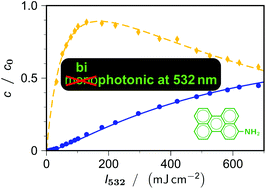Green-light ionization of 3-aminoperylene in SDS micelles—a promising access to hydrated electrons despite a myth debunked†
Abstract
Using an improved methodology, we have carefully reinvestigated the title reaction by laser flash photolysis and disproved an earlier study (J. K. Thomas and P. Piciulo, J. Am. Chem. Soc., 1978, 100, 3239), which claimed this green-light ionization to be monophotonic, the only instance of such a scenario ever reported for a stable compound. We show it to be biphotonic instead, in accordance with thermodynamic considerations, and present a photokinetic model that accurately represents the intensity dependences throughout the whole excitation range in the green (532 nm) and the near UV (355 nm), up to near-quantitative electron release in the latter case. A major artifact deceptively similar to a chemical decay arises from an SDS-related laser-induced turbidity but can be eliminated by difference experiments or careful selection of excitation intensities and temporal windows. The ionization step is not accompanied by side processes, and affords an extremely long-lived (0.35 s) radical cation remaining solubilized. The micelles completely block attacks of hydrated electrons or hydroxyl radicals on the starting material and its radical cation but allow a post-ionization regeneration by high concentrations of the hydrophilic ascorbate monoanion.


 Please wait while we load your content...
Please wait while we load your content...